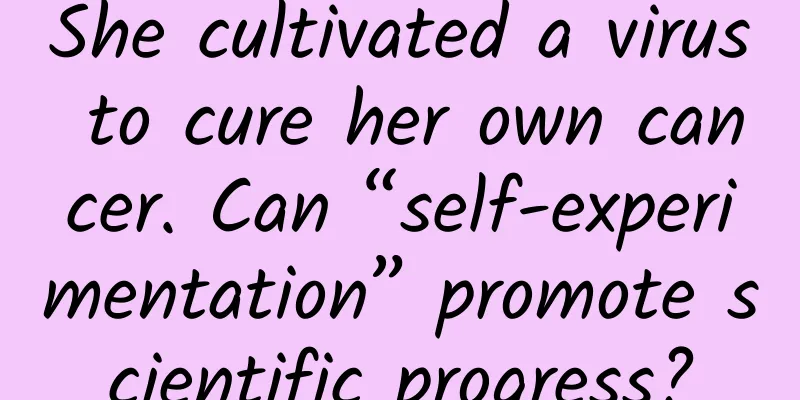She cultivated a virus to cure her own cancer. Can “self-experimentation” promote scientific progress?

|
In 2020, Beata Halasi's breast cancer recurred for the second time. She had the most aggressive and dangerous subtype of breast cancer, and what was worse was that she could not continue to receive chemotherapy. This was almost a death sentence. But fortunately, she was a virologist, and after reading a lot of literature, she decided to try oncolytic virus therapy, which had not been proven in breast cancer before. With the help of his colleagues, Halasi injected the cultured virus into the tumor. After two months of treatment, the tumor was significantly reduced in size, from hard to soft, with no serious side effects. In addition, the aggressive edges of the tumor also regressed, making it easier to remove surgically. Analysis of the resected tumors showed that the tumor was completely infiltrated by lymphocytes, indicating that oncolytic virus therapy had played its intended role and stimulated the immune system to attack viruses and tumor cells. After the operation, Halasi received a year of anti-cancer drug treatment. In August of this year, Halasi published his case report on anti-cancer treatment in Vaccines. Written by | Wang Chenguang Cancer has always been a major problem in modern medicine. Despite the continuous enrichment of treatment methods, many patients still face the situation of no cure at some stage of the disease. Against this background, the concept of virus treatment for cancer has gradually entered the public eye. In recent years, Croatian virologist Beata Halassy has conducted research on virus treatment for breast cancer and published the experimental results in scientific journals. What is remarkable is that Halassy not only participated in the research, but also personally used the virus developed in the laboratory to treat her own diagnosed breast cancer. This bold move has attracted widespread attention from the media and the public to virus therapy. Beata Harasi | Ivanka Popić It should be pointed out that virotherapy is not an original invention of the Halasi laboratory. As early as the beginning of the 20th century, this concept was proposed and has undergone many years of development. Halasi's research provides further data support based on the predecessors. Virotherapy has brought new hope to cancer patients and demonstrated its potential in tumor treatment. However, as Halasi's self-treatment has sparked heated discussions, medical ethical issues have also surfaced. The history of scientists' self-experiments and the ethical challenges of virotherapy are also worthy of in-depth thinking. Viruses can be weapons against cancer When people mention "viruses", they often think of deadly infectious diseases such as smallpox, Ebola and COVID-19. However, viruses are not only a threat to human health. Under certain conditions, they can also become weapons against cancer. Oncolytic virotherapy is a treatment method that uses viruses to infect tumor cells and destroy tumor tissue. Through genetic engineering technology, scientists can design specific viruses to target tumor cells while avoiding damage to normal cells. In her research in the field of breast cancer, Beata Harasi has successfully used genetically modified oncolytic viruses to target cancer cells. Her team has finely edited the virus to specifically attack breast cancer cells without harming normal tissues. This targeting greatly reduces damage to normal cells during treatment and also reduces the risk of side effects. Through preclinical experiments, the research of the Harasi team showed that the modified virus can not only effectively kill cancer cells, but also activate the patient's own immune system to enhance the ability to remove residual tumor cells. This discovery provides a new treatment idea for breast cancer patients and shows potential in a wider range of cancer treatments. Although Harasi's research is refreshing to the media and the public, oncolytic virus therapy is not a new concept. As early as the beginning of the 20th century, medical scientists found that some patients' tumors showed signs of shrinkage or even disappearance after being infected with viruses. This phenomenon provided the initial inspiration for the research of oncolytic virus therapy. In the mid-20th century, American scientists discovered that rubella virus can inhibit the growth of certain cancer cells in vitro, which laid the foundation for the development of viral therapy. In the 21st century, with the rapid development of gene editing technology, scientists were able to precisely design viruses, greatly enhancing their ability to specifically target cancer cells. In 2015, the U.S. Food and Drug Administration (FDA) approved the first oncolytic virus drug, T-VEC (Talimogene laherparepvec), for the treatment of advanced melanoma. This milestone marked a key step in the transition of viral therapy from the laboratory to the clinic. Since then, more and more clinical trials have shown that oncolytic virus therapy has shown promise in a variety of cancer types, including lung cancer, brain cancer, and prostate cancer. Oncolytic viruses (OV) do not refer to a specific virus, but to all viruses that can selectively infect and kill tumor cells. Oncolytic virus therapy is different from traditional cancer treatment methods. It exerts anti-tumor effects through two main mechanisms. The first is to directly "dissolve" tumor cells. Oncolytic viruses can infect and replicate in tumor cells, decompose infected cells and spread to other tumor cells, eventually leading to tumor cell lysis and death. The second is to stimulate the immune response. It activates the host's immune system by releasing tumor-associated antigens and produces a sustained anti-tumor immune response. This dual effect enables oncolytic viruses to not only have the effect of directly killing tumors, but also mobilize the host's immune system for more extensive tumor clearance, thereby providing more lasting efficacy than traditional therapies in some cases. Moreover, modern genetic engineering technology can modify oncolytic viruses to make them more specifically infect tumor cells. For example, cytokine genes (such as GM-CSF) can be inserted to further enhance local anti-tumor immune responses. In recent years, oncolytic viruses have made significant progress in research and clinical applications, and a variety of viruses have been tried for cancer treatment. For example, T-VEC is a genetically modified herpes simplex virus (HSV-1) approved in the United States for the treatment of melanoma. T-VEC is injected directly into the tumor site to infect and kill tumor cells, while activating local immune responses, thereby enhancing the immune attack on cancer cells. Adenovirus is another common oncolytic virus that is widely used in oncolytic virus research because it is easy to modify and has a wide spectrum of infection. "Ankorui" is the first adenovirus oncolytic virus approved in China for the treatment of head and neck squamous cell carcinoma. Measles virus has become a research hotspot in recent years due to its natural immunogenicity and tumor targeting. Measles virus oncolytic therapy has shown potential in clinical trials for a variety of cancers such as ovarian cancer and melanoma. Exogenous pathogens “arsenal” In addition to viruses, bacteria also have a long history of research in tumor treatment. William Coley was a pioneer in bacterial therapy. At the end of the 19th century, he found that some cancer patients' tumors shrank or regressed after being infected with bacteria. Based on this, he speculated that the immune response triggered by the infection might help kill tumor cells. Coley developed a mixture of "Coley toxin" containing inactivated streptococci and other bacteria, which was injected to stimulate the patient's immune system to fight tumors. Although this therapy was later replaced by modern anti-cancer technology, it laid an important foundation for immunotherapy. The application of bacteria in tumor treatment is based on their ability to proliferate in the hypoxic, nutrient-rich tumor microenvironment. The ability of anaerobic bacteria such as Clostridium to grow in tumor tissues has prompted scientists to explore their potential as anti-tumor carriers. Through genetic modification, bacteria can carry anti-cancer genes or toxins and release them in a targeted manner inside the tumor, thereby enhancing the killing effect. In addition, bacterial infection can also activate the immune system, further promoting tumor clearance. For example, the genetically modified Salmonella VNP20009 can proliferate in hypoxic areas of tumors and release anti-tumor factors, and has now entered Phase I clinical trials for melanoma and solid tumors. Clostridium and Escherichia coli are also widely used in bacterial anti-cancer research, showing great potential, but safety and toxicity control remain challenges for future clinical applications. The main challenges facing bacterial therapy include how to control the toxicity of bacteria to prevent them from harming normal tissues, and the difficulty in precisely controlling the distribution and reproduction of bacteria in the body. Therefore, further research is needed to optimize the safety and targeting of bacteria. With the development of synthetic biology, scientists are using more sophisticated gene editing techniques to transform bacteria so that they can play a more precise therapeutic role in the tumor microenvironment. In addition to viruses and bacteria, other exogenous microorganisms have also been studied for their anti-tumor effects, such as fungi and parasites. The unique mechanisms of these microorganisms have shown new ideas for anti-tumor treatment. Back to oncolytic virus therapy, although it has shown certain clinical potential, it also faces some problems. One of the biggest problems is how to ensure the effectiveness of the treatment while avoiding side effects, especially the mechanism of action on the immune system is still not fully understood. Although viral infection can directly destroy cancer cells and activate the immune system by releasing antigens to produce anti-tumor immune responses, the specific regulatory mechanism of this process is complex and still needs further study. One of the key challenges is the complex relationship between the virus and the host immune system. Not only can the immune system be activated by the virus to attack the tumor, but it may also quickly clear the therapeutic virus, thereby limiting its spread and effect in the tumor. How to balance this "immune balance" has become the focus of research. In addition, there are differences in how the virus selectively attacks cancer cells without damaging normal cells, especially in the effectiveness and safety of different types of tumors. To overcome these problems, researchers are exploring genetically modified viruses and combination therapies to enhance the selectivity and immune activation effects of oncolytic viruses. Those who are brave enough to "experiment with themselves" The news effect was not caused by the progress of virus treatment for cancer, but by the fact that Harasi used a virus developed in the laboratory to treat his own cancer and published the results in the form of an academic paper. Apart from the technical issues of virus treatment for cancer, is there anything wrong with this behavior itself? Halasi used her own research to treat her breast cancer, which can be classified as "self-experimentation." This is not uncommon in the history of life sciences. Many scientists have even used themselves as test subjects in order to promote scientific progress. For example, in the 1980s, Australian doctor Barry Marshall proposed that stomach ulcers were not caused by stress or diet, but by a bacterium called Helicobacter pylori. However, this hypothesis was widely questioned by the medical community at the time. To prove his theory, Marshall decided to infect himself with the bacteria. He drank a solution containing Helicobacter pylori and quickly developed symptoms of stomach ulcers, which were successfully cured with antibiotics, ultimately proving his theory. This courageous self-experiment revolutionized the treatment of stomach ulcers and won him the 2005 Nobel Prize in Medicine. While working at Thomas Jefferson University, I was involved in hosting Dr. Marshall and hosted a lunch meeting between doctoral students and Marshall. At the meeting, a student asked why Marshall chose to verify his research hypothesis himself. Marshall recalled the difficulties he faced during the research process at that time, especially the strong doubts from his peers. He mentioned that despite submitting the article many times, it was repeatedly rejected and published by the journal. In such a questioning environment, it was obviously extremely difficult to obtain approval for clinical trials based on research conclusions. In the late 19th century, American doctor Walter Reed led a study to try to uncover how yellow fever was transmitted. In order to confirm the theory that yellow fever was transmitted by mosquitoes, Reed and his team decided to expose themselves to the risk of infection. They let mosquitoes bite them and recorded the development of the symptoms. Although this experiment played a decisive role in promoting yellow fever research, it also led to the infection of several scientists and experimental participants, and even killed some people. John Hunter, an 18th-century surgeon, is known for his contributions to physiology, but some of his experiments were controversial. To study sexually transmitted diseases, he injected secretions from people with gonorrhea and syphilis into himself to observe the spread of the disease and the development of symptoms. This risky self-experimentation provided some important data for medicine, but also led to his own health problems in his later years. Albert Calmette and Camille Guérin: In 1921, they inoculated themselves with live Pasteurella to demonstrate that it could stimulate an immune response to tuberculosis. This experiment led to the creation of the BCG vaccine, which is still used to prevent tuberculosis today. Hans Jäger: He voluntarily became infected with HIV in the 1950s in order to study the effects and spread of this new pathogen, an event that sparked widespread controversy at the time and sparked discussions about ethics and scientific methods. The ethical challenges of “self-experimentation” The exploration of using pathogens such as viruses to treat cancer demonstrates the innovation and progress of modern medicine and brings new hope to patients. The research of scientists such as Harasi has injected new impetus into this field, transforming viruses from simple pathogens into tools to fight cancer. However, "self-experimentation" comes with significant ethical risks. Scientists promote medical progress through self-experimentation, which is sometimes seen as a symbol of dedication, but it has also sparked profound ethical controversy. Although self-experimentation has decreased in modern medicine, scientific research, especially clinical trials of innovative drugs, cannot be absolutely safe. How to define the boundaries of human safety remains a key ethical issue. First, the act of researchers conducting experiments on their own bodies itself involves serious ethical challenges. General clinical research requires review and approval from a third-party ethics committee to ensure that the experiment complies with medical ethics standards. Self-experimentation may skip these necessary reviews, leading to potential conflicts of interest, or even conducting experiments without assessing risks. Secondly, without sufficient samples or control variables, the data from self-experiments are unlikely to be widely applicable or representative in science. Even if the experimental results are effective for an individual, there is no guarantee that they will be equally effective in other patients, which makes the scientific rigor of the results questionable. Third, the use of experimental therapies outside of formal clinical trials (such as incompletely validated viral treatments) carries significant safety risks. Without rigorous clinical trials and regulatory approval, the use of such therapies could result in unexpected side effects or adverse outcomes, and without proper medical supervision further increases these risks. Fourth, Halasi’s public disclosure of her own experimental results in the paper and the conclusion that viral therapy is effective may trigger discussions about academic conflicts of interest. As the initiator and experimental subject of the study, her results may not remain neutral, which will affect the scientific community’s trust in the research conclusions. Based on the above points, coupled with media hype and public discussion, the research results may convey false hope or information to the public, misleading them to believe that a certain treatment method is effective when it has not been fully verified. Especially in countries and regions where "alternative therapies" still have a huge market, this behavior may lead to or aggravate industry chaos, with various therapies that have not been strictly clinically verified competing to appear on the market. In addition, it is very unreliable to "guide" health decisions based on the secondary interpretation of the latest research by the media and the public. Even if the original papers are directly consulted, it is difficult for ordinary people to accurately understand the research content and make reasonable judgments due to their lack of professional background. Therefore, it is not recommended for ordinary people to obtain medical knowledge from newly published scientific papers. Even if a certain study involves personal interests, it should be treated with caution and it is best to consult an expert. (See "Will those who live according to the "latest research" live a healthier life?" for details) Virus therapy represents an important direction for cancer treatment, but the development of science cannot be separated from ethical constraints. In the future, with the joint advancement of technology, ethics and law, virus therapy is expected to become a safe and effective conventional cancer treatment method, helping more patients control cancer. Acknowledgements: We would like to thank Professor Xie Songqiang from the School of Medicine of Henan University for reviewing this article. Special Tips 1. Go to the "Featured Column" at the bottom of the menu of the "Fanpu" WeChat public account to read a series of popular science articles on different topics. 2. Fanpu provides a function to search articles by month. Follow the official account and reply with the four-digit year + month, such as "1903", to get the article index for March 2019, and so on. Copyright statement: Personal forwarding is welcome. Any form of media or organization is not allowed to reprint or excerpt without authorization. For reprint authorization, please contact the backstage of the "Fanpu" WeChat public account. |
>>: How did the Eight Immortals cross the sea? What magical powers did they display?
Recommend
China's "Big Goose", the world's first
Author: Wen Lele Geese may have been domesticated...
Tesla may upgrade its super charging piles to fully charge in 10 minutes
Among the charging services provided by Tesla, mo...
How good is AI at making up stories? It's beyond your imagination!
Have you ever encountered such a situation: you a...
The film law is here! Is the rating system far behind?
From its drafting in 2003 to its first review by ...
Taking medicine on time is more important than you think! Don't ignore these situations
When doctors prescribe medicine, they sometimes r...
Why are the water resources in the Taklamakan Desert far superior to those in other deserts in the world?
The world's largest deserts, such as the 7.77...
To eat this delicious mushroom, you may need to go to the desert to dig sand
Recently, there is a video that has been going vi...
Shocking: The top 10 most popular apps in the United States are owned by three major companies
The latest data released by Nielsen shows that th...
Why do we have to develop a hydrogen bomb, he said -
He is the recipient of the "Medal of the Rep...
Important reminder! Regarding travel during the National Day holiday!
The National Day holiday is approaching, and the ...
Does a "gluten-free diet" mean not eating whole grains? What is gluten allergy?
Audit expert: Peng Guoqiu Deputy Chief Physician,...
The super cool starry sky "palette" in the hands of the cosmic painter, you may have never seen it before
Author | Feng Ziyang Review | Dong Chenhui Editor...
The five necessary stages for information flow delivery! Attached is an excellent case study in the gaming industry~
In 2017, legendary and fairy-tale games spent a l...
Baidu video promotion, vertical video information flow advertising style!
Information flow advertising style - vertical vid...
Suxuan·Workplace Growth Camp|Everything is under control and everyone can understand it
【Completed】[Career Growth Camp Tool Kit] 01|SOP M...









